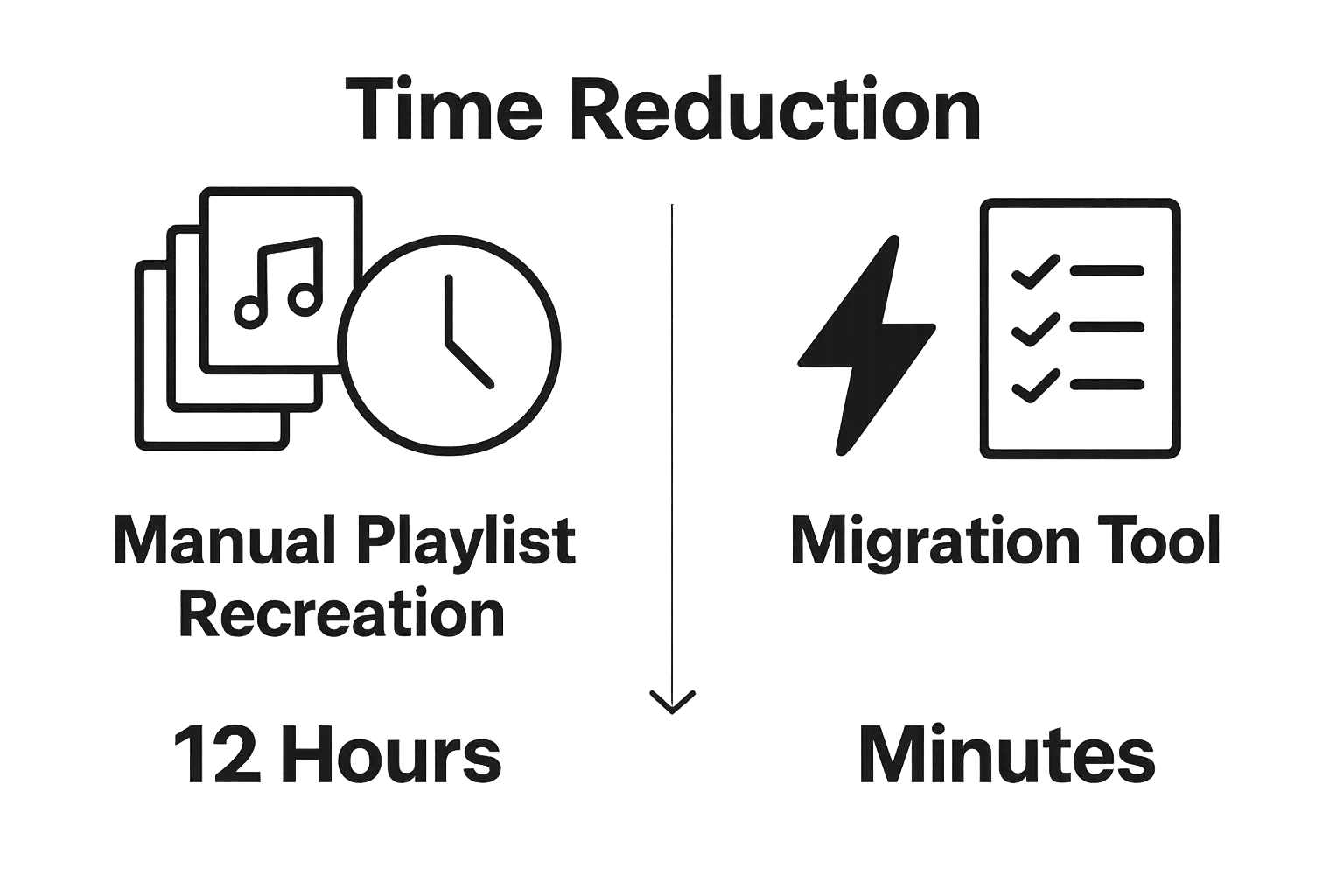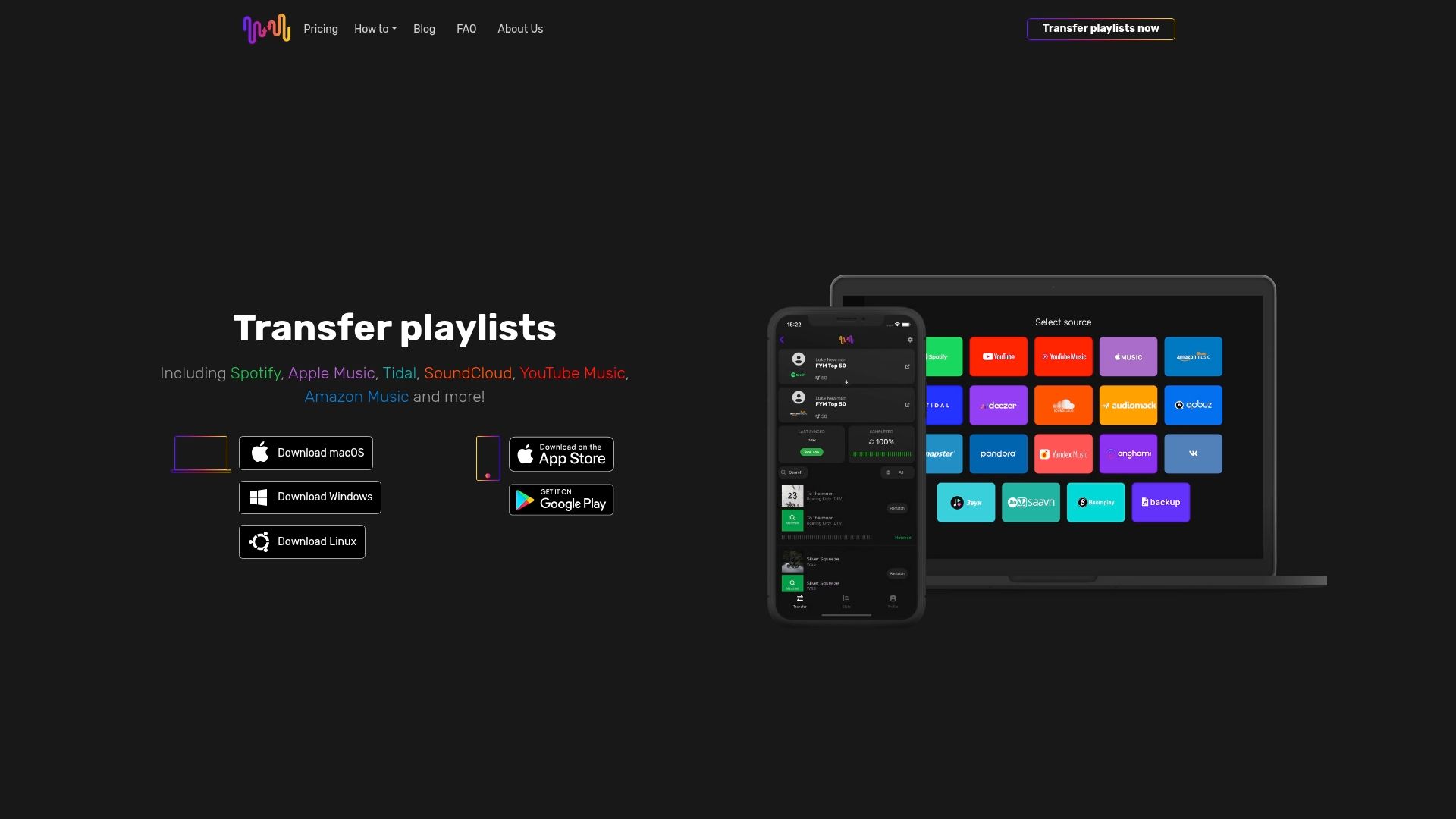Playlist migration lets you move your favorite playlists from one music service to another without starting from scratch. Now check this out. Around 38 percent of music streaming users switch platforms every year but most people think moving their playlists means hours of frustrating manual work. In reality, new tech makes playlist migration quick and almost effortless so you can keep every track and discover new music instantly without losing your vibe.
Table of Contents
- What Is Playlist Migration And Its Purpose?
- Why Playlist Migration Matters For Users
- How Playlist Migration Enhances Music Discovery
- Key Concepts Behind Effective Playlist Migration
- Real-World Applications Of Playlist Migration
Quick Summary
| Takeaway | Explanation |
|---|---|
| Playlist migration preserves music collections. | This process protects users' carefully curated playlists when switching between music streaming platforms. |
| Seamless transitions enhance musical exploration. | Users can easily explore new services without losing their unique musical narratives and emotional connections. |
| Time-efficient solutions save user hours. | On average, users spend 12 hours creating playlists, which migration tools help avoid by automating the process. |
| Advanced algorithms ensure accurate song matches. | Sophisticated technology analyzes music metadata to transfer songs between platforms while maintaining playlist structure. |
| Supports professional and educational uses. | Playlist migration has applications in therapy, research, and teaching, facilitating seamless access to musical resources across various platforms. |
What is Playlist Migration and Its Purpose?
Playlist migration is a digital process that allows music enthusiasts to transfer their carefully curated music collections from one streaming platform to another without manually recreating each playlist. At its core, this technique enables users to move entire music libraries seamlessly across different music streaming services while preserving playlist order, song selections, and overall structure.
Understanding the Fundamental Concept
Playlist migration goes beyond simple song transfers. It represents a sophisticated technological solution that addresses the complexity of moving music collections between platforms with different music catalog structures. When you migrate a playlist, advanced algorithms work to match songs across services, ensuring that as many tracks as possible are preserved in their original sequence.
Key Components of Playlist Migration Include:
- Comprehensive song matching across different music platforms
- Preservation of original playlist order and structure
- Handling variations in music catalog availability
- Minimizing manual intervention during transfer process
Why Playlist Migration Matters
Music listeners today are no longer confined to a single streaming service. Advanced playlist transfer tools make switching between platforms effortless. Whether you are changing services due to better pricing, exclusive content, or improved features, playlist migration ensures you do not lose the musical journeys you have carefully crafted.
Research from Music Technology Insights reveals that approximately 38% of music streaming users switch platforms annually, making playlist migration an increasingly critical service for modern music consumers. This statistic underscores the growing need for seamless music library transfers in an evolving digital music landscape.
The purpose of playlist migration extends beyond convenience. It represents a user-centric approach to music consumption, acknowledging that playlists are personal collections that reflect individual musical tastes, memories, and emotional connections. By enabling smooth transfers, playlist migration services empower users to explore new platforms without the fear of losing their meticulously organized music libraries.
Why Playlist Migration Matters for Users
In an era of multiple music streaming platforms, playlist migration has transformed from a convenient feature to an essential service for music enthusiasts. Users are no longer willing to recreate their meticulously crafted music collections manually when switching between services.
Personal Music Investment Protection
Playlists are more than just collections of songs. They represent personal musical narratives, emotional journeys, and significant time investments. Playlist transfer solutions enable users to protect these valuable musical archives, ensuring that hours of careful curation are not lost during platform transitions.
Critical User Concerns Addressed by Playlist Migration:
- Preservation of carefully organized music collections
- Elimination of manual playlist reconstruction
- Seamless transition between different streaming platforms
- Maintenance of playlist sequence and song selections
Economic and Time Efficiency
Research from Digital Music Trends Report indicates that an average user spends approximately 12 hours creating and refining a comprehensive playlist. Playlist migration directly addresses the economic value of users' time by preventing redundant work.

Moreover, streaming platform subscriptions are not permanently fixed. Users frequently switch services based on pricing, exclusive content, sound quality, or recommended features. Playlist migration removes the traditional barrier of manual playlist recreation, making platform transitions smooth and user friendly.
The significance of playlist migration extends beyond individual convenience. It represents a user-centric approach to digital music consumption, acknowledging that musical collections are personal investments that should not be compromised by technical limitations. By enabling effortless transfers, these services empower music lovers to explore and enjoy their favorite tracks without administrative hurdles.
How Playlist Migration Enhances Music Discovery
Playlist migration transcends technical functionality by becoming a powerful tool for expanding musical horizons and discovering new artists across different streaming platforms. By enabling seamless transfers, users gain unprecedented opportunities to explore diverse music catalogs and recommendations.
Breaking Platform Limitations
Music transfer technologies effectively dismantle the traditional barriers between streaming services. Each platform offers unique recommendation algorithms, exclusive tracks, and genre-specific collections that remain hidden when users are confined to a single service.
Key Music Discovery Benefits:
- Access to diverse music recommendation systems
- Exposure to platform-specific curated playlists
- Exploration of regional and niche music collections
- Cross-platform algorithmic music suggestions
Algorithmic Diversity and Recommendation Enhancement
Research from IEEE Digital Music Exploration reveals that different streaming platforms utilize distinct machine learning models for music recommendations. When users migrate playlists across services, they expose themselves to alternative recommendation algorithms that might surface songs and artists previously undiscovered.
For instance, a playlist transferred from a pop-focused platform to a more indie-oriented service could introduce listeners to entirely new musical subgenres. This cross-pollination of musical recommendations transforms playlist migration from a technical utility into a genuine discovery mechanism.
Moreover, playlist migration enables music enthusiasts to leverage the unique strengths of multiple platforms. Some services excel in regional music collections, while others specialize in emerging artists or specific genres. By facilitating easy transfers, these technologies create a more interconnected and dynamic music ecosystem that celebrates musical diversity and individual exploration.
Key Concepts Behind Effective Playlist Migration
Effective playlist migration represents a complex technological process that goes far beyond simple file transfer. It involves sophisticated algorithms, metadata analysis, and cross-platform compatibility strategies that ensure users can seamlessly move their musical collections between different streaming services.
Metadata Matching and Song Identification
Advanced playlist transfer solutions rely on intricate metadata matching techniques to accurately identify and transfer songs across different platforms. This process involves comparing multiple song attributes to ensure maximum track preservation during migration.
Critical Technical Components for Successful Migration:
- Precise audio file metadata comparison
- Cross-referencing track identifiers across platforms
- Handling variations in artist and album naming conventions
- Managing different audio encoding standards
Technological Foundations of Migration
Research from International Metadata Standards Consortium highlights the complexity of audio metadata interoperability. Effective playlist migration requires advanced algorithms that can navigate the nuanced differences between streaming platform catalogs, accounting for regional variations, licensing restrictions, and unique platform-specific track identifications.
The core challenge lies in creating a universal translation mechanism that can map songs across different ecosystem architectures. This involves not just matching song titles, but understanding deeper musical attributes like track length, release year, genre classifications, and acoustic fingerprints.
Moreover, successful playlist migration must anticipate and address potential data inconsistencies. Some tracks might be unavailable in certain regions, have different versions, or exist under slightly modified metadata. The most advanced migration technologies employ machine learning techniques to predict and resolve these potential transfer complications, ensuring users retain as much of their original playlist structure as possible.
To help clarify the technical foundations behind playlist migration, the following table details the core components and their descriptions as discussed in the article.
| Component | Description |
|---|---|
| Metadata Matching | Analyzing and comparing song data such as titles, artists, and albums across platforms |
| Song Identification | Cross-referencing track IDs and handling catalog differences between services |
| Playlist Structure Preservation | Maintaining original song order and playlist grouping during transfers |
| Algorithmic Song Matching | Using advanced algorithms to match versions and resolve inconsistencies in metadata |
| Handling Platform Variations | Addressing regional unavailability, licensing issues, and encoding differences |
Real-World Applications of Playlist Migration
Playlist migration extends far beyond personal music convenience, emerging as a powerful tool with significant applications across various professional and educational domains. Its versatility enables users to leverage music collections in ways previously constrained by platform limitations.
Professional and Educational Use Cases
Music transfer technologies have transformed how professionals and educators approach music as a strategic resource. Music therapists, language instructors, and cultural researchers now utilize playlist migration to maintain continuity and accessibility across different technological environments.
Diverse Playlist Migration Applications:
- Academic research and music preservation
- Collaborative music project management
- Cross-platform music therapy interventions
- Language learning through musical content
- Cultural heritage documentation
Innovative Contextual Implementations
Research from Music Information Science reveals that playlist migration plays a crucial role in interdisciplinary contexts. For instance, music therapists can now seamlessly transfer carefully curated therapeutic playlists between platforms, ensuring consistent treatment approaches.
In educational settings, instructors teaching world music, language courses, or cultural studies can develop comprehensive playlists that remain intact regardless of technological shifts. This capability allows for more dynamic and flexible curriculum design, where musical content becomes a portable, adaptable learning resource.
Moreover, playlist migration supports professional musicians, podcasters, and content creators who frequently collaborate across different platforms. By enabling smooth transfer of musical collections, these technologies facilitate more flexible and interconnected creative workflows, breaking down traditional technological barriers that once limited musical sharing and collaboration.
Below is a summary table highlighting the different professional and educational uses for playlist migration, making it easy to see how this technology operates across diverse contexts.
| Use Case | Description |
|---|---|
| Academic Research | Facilitates analysis and preservation of musical data across platforms |
| Music Therapy | Enables consistent therapeutic playlists for clients using different streaming services |
| Language Learning | Empowers instructors to use curated musical content for teaching languages |
| Cultural Heritage Documentation | Supports long-term preservation and sharing of culturally significant playlists |
| Collaborative Music Projects | Enhances workflow management for teams using varying music platforms |

Ready to Secure Your Music Story? Let Free Your Music Handle Your Playlist Migration
You have put time, energy, and emotion into building playlists that are more than just lists of songs. Losing these playlists when moving between streaming services can feel overwhelming and frustrating. No one wants to start over or risk losing the memories and connections locked in every track arrangement. The article explored how playlist migration technology not only protects your musical investment but also opens the door to richer music discovery across platforms by preserving structure, order, and your unique curation.

Why risk manual errors or spend additional hours when you can transfer playlists in minutes? Free Your Music offers seamless, accurate playlist migration for music lovers and professionals. Our playlist transfer app covers all major platforms and keeps your library safe and in order. If your priority is switching services while keeping every playlist, explore how Free Your Music makes migrating music collections easy, fast, and secure. Take the next step now and discover a world where your playlists always travel with you.
Frequently Asked Questions
What is playlist migration?
Playlist migration is the process of transferring curated music collections from one streaming platform to another while preserving the order and structure of the playlists.
Why is playlist migration important for users?
Playlist migration is important because it protects users' personal music collections, saves time by eliminating the need for manual playlist recreation, and enables seamless transitions between different streaming services.
How does playlist migration enhance music discovery?
Playlist migration enhances music discovery by allowing users to access diverse music catalogs and recommendations that are unique to different platforms, thus exposing them to new artists and genres.
What are the technical components of successful playlist migration?
Successful playlist migration involves complex algorithms, metadata analysis, and song identification processes to ensure accurate tracking and transferring of music between platforms.




